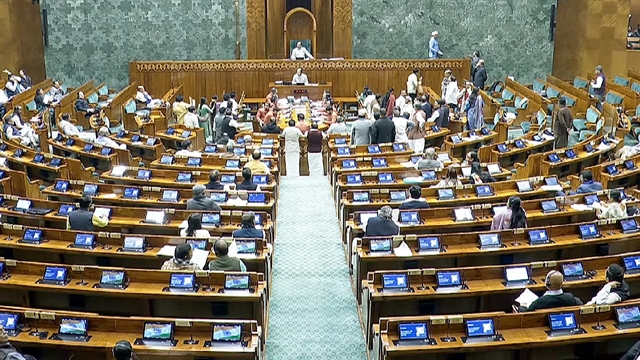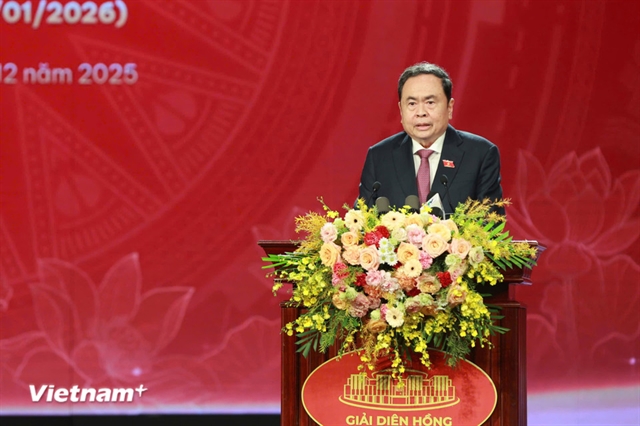.jpg) Society
Society

 |
| Minister of Education and Training Nguyễn Kim Sơn speaks with candidates taking the high school graduation exam at Hai Bà Trưng High School in Vĩnh Phúc Province. — VNA/VNS Photo |
HÀ NỘI — More than 1.15 million students across the country began the 2025 National High School Graduation Exam on June 26.
This year’s exam is unlike any before it. It is the first national high school graduation exam held under the new 2018 general education curriculum, which emphasises competency, flexibility and real-life application of knowledge.
It also takes place during a critical period of government reform, as Việt Nam moves to streamline its local administrative apparatus into a more efficient two-tier system, effective from July 1.
Two curricula, one exam
To accommodate students graduating under both the 2006 and 2018 curricula, the Ministry of Education and Training implemented an unprecedented dual-structure approach. That means two different exam formats, two separate sets of regulations and in many places, separate exam centres.
Of the more than 1.15 million candidates who registered, 1,130,196 students sat the exam under the 2018 curriculum, while around 22,140 students took part under the older 2006 programme, which is being phased out.
This dual approach aims to ensure fairness for all students, regardless of the curriculum they followed.
Students under the 2006 system will take six subjects in total, while their peers under the new curriculum will sit for four subjects, including two compulsory ones (Math and Literature) and two electives chosen from among 13 available subjects - an expanded list that includes Informatics, Economic and Legal Education, Agricultural Technology and Industrial Technology.
Coordinated effort
The 2025 exam also coincides with major governmental restructuring, such as merging provincial inspection bodies into the national Government Inspectorate and shifting some policing responsibilities from district to commune level.
Amid these changes, Prime Minister Phạm Minh Chính issued two urgent directives, emphasising that the exam must proceed safely and smoothly, unaffected by the institutional shake-ups.
The directives called for clear responsibility assignment, rigorous oversight and comprehensive support for candidates. Provincial leaders were instructed to ensure all elements, from exam security to student transport, were handled with precision.
Deputy Prime Minister Lê Thành Long personally led government inspection teams to localities to assess preparation. Vice Minister of Education Phạm Ngọc Thưởng, who also heads the national exam organising committee, said that provinces had been proactive and that no major problems had been reported.
Field visits and exam site preparations
Minister of Education Nguyễn Kim Sơn travelled to Vĩnh Phúc Province on exam day to inspect two testing locations, Hai Bà Trưng High School and Trần Phú High School.
At Hai Bà Trưng School, 595 candidates sat for the Literature exam across 25 exam rooms, supported by nearly 100 staff members. All students at this site followed the 2018 curriculum.
The Minister personally visited exam rooms, spoke with students and teachers and encouraged them ahead of the test. He later praised Vĩnh Phúc Province for its meticulous preparation, spanning facilities, proctor training, medical readiness and logistics for disadvantaged students.
Vice Chairman of Vĩnh Phúc Trần Duy Đông emphasised the province’s long-standing commitment to education. With 30 testing locations, over 700 exam rooms and 2,480 personnel, Vĩnh Phúc is managing exams for more than 16,000 students under the 2018 curriculum and 332 students under the 2006 programme.
New exam formats and content
The literature exam, taken by over 1.15 million candidates, remained the only subject tested in the traditional essay format, lasting 120 minutes.
However, there were changes. The 2018 curriculum’s version of the paper placed greater emphasis on reading comprehension (four points) and writing (six points), and notably, it included materials from outside the textbook. This shift required students to demonstrate flexible thinking, rather than rote memorisation.
In the afternoon, students took the mathematics exam, which also saw structural changes. The number of questions was reduced from 50 to 22, distributed across three parts, covering 12 standard multiple-choice questions, four true/false multi-item questions, and six short-answer questions.
The Ministry announced that, beginning this year, multiple-choice exams will follow a three-part format, with new scoring methods that assign partial credit for partially correct answers in Part 2. This allows for more nuanced evaluation of student performance.
Candidates under the 2018 curriculum will complete their exams by the morning of June 27, after sitting three sessions: Literature, Math, and an elective block of two subjects.
Those under the 2006 curriculum will complete four sessions, finishing in the afternoon of June 27, including a foreign language component and either a Natural or Social Sciences test block.
After the exam, grading will begin in early July, during the same period when provincial mergers and system reforms are underway.
The Ministry has urged local authorities to maintain the same level of care and precision during grading as in the exam phase, particularly as the 2018 curriculum introduces more subjects and added complexity. — VNS


.jpg)

